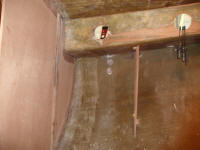
110 Cookson Lane | Whitefield, ME 04353 | 207-232-7600 | tim@lackeysailing.com
Westsail 667 Thursday, November 14, 2013
We started on the head's forward bulkhead, which we'd begun preparing the day before. Up in the boat, we aligned the small section of bulkhead with various alignment marks, and fine-tuned the positioning till it was plumb and parallel with the main bulkhead behind. To help pattern the larger main section of this bulkhead, we secured the small piece with hot glue blocks, clamps, and screws as needed to hold it in position.
The cardboard pattern we'd started with already covered most of the remaining bulkhead section, but wasn't wide enough to extend to the centerline, so we taped the large pattern section in place next to the small plywood bulkhead we had temporarily secured, then made notations as needed to indicate the final overall width (leaving it a bit overwide to allow for final trimming in place), and patterned the section that dipped into the bilge sump.
Laying the pattern on a new sheet of plywood, I traced out the outline as needed, and we prepared to cut it out. While Brian cut out the bulkhead and routed the seam dado, I sanded the inside of the boat in way of this bulkhead to prepare the surface for bonding, then cleaned up the sanding dust and mess.
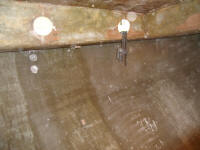

Thusly prepared, and with the small, outboard section back in place (temporarily), we checked the fit of the large section. To my dismay, it was short at the top: I'd neglected to transfer the top's shape with the proper offset when I traced it onto the plywood, rendering it short. Fortunately, there was more plywood on hand, and the large cut sheet could be used elsewhere, but what a waste of time. So after transferring the pattern to another sheet, this time taking care to get the lines in the right place, Brian proceeded to cut out the new one; meanwhile, I permanently installed the smaller outboard section in the usual way, coating the raw plywood edge with epoxy before securing the bulkhead in a bed of thickened epoxy adhesive and attaching it to the temporary glue blocks with screws and clamps.

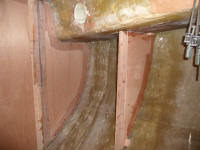
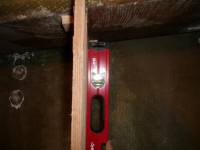
The newly (and correctly) cut bulkhead section fit properly inboard of the piece I'd just installed, so after final fitting and preparing various glue blocks to help hold it in position, we installed it, holding it securely in alignment with its neighbor with a batten across the seam. Later, we'd trim the inboard edge plumb and to the proper final width.
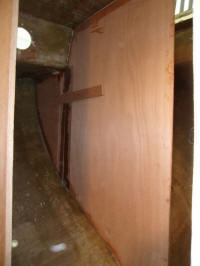
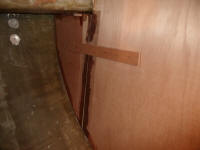
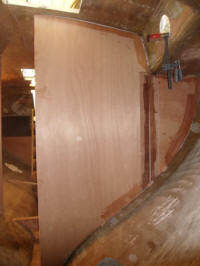
The last major imaginary structure Brian wanted to work on was the cabin sole. We'd already established the essential height of the sole at the forward end of the cabin with the laminated plywood beam at the base of the bulkhead, so to extend this line aft and create the plane of the (level) cabin sole, we set up a string with a small level attached, and, after leading it tightly to the after engine room bulkhead, made a mark for a hole through which we could lead and secure the string down the centerline (well, technically 3/4" to port of centerline fore and aft) of the boat for reference in establishing the sole position. We installed a horizontal (level) cleat at this point on the after bulkhead, a temporary measure to help locate various points of the cabin sole on the hull itself.
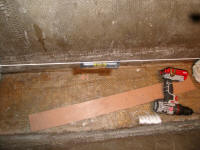
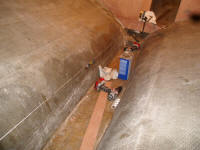
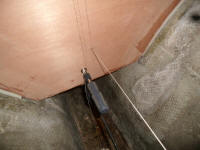
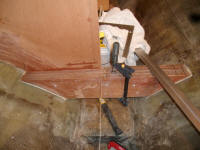
By holding levels on the top surface of this cleat, as well as on the main sole support (aka structural floor) at the forward bulkhead, it was easy to transfer the height of the sole (specifically the bottom of the sole substrate) to the hull on each side in various locations, angling the level out from the cleat till its far corner touched the hull. In the center portion, we used a short level held tangent to the level centerline string to transfer the position outboard to the hull. The net result was a series of tick marks on each side of the hull, spaced a foot or two apart, that represented the shape and position of the bottom of the cabin sole substrate, showing a platform roughly 35" at its widest point. Black tick marks are visible in these photos, though not necessarily immediately.
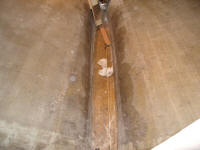

To provide bearing surfaces for the sole, and somewhat reduce its span, we laid out for several blocks along the outboard edge, which would support the platform without adding bulk or unwanted depth beneath. We formed these from 1-1/2" structural polyurethane foam, starting with triangle-shaped sections (two thicknesses glued together to make a 3" wide support) that we shaped to fit the curvature of the hull, keeping the top surface level and even with the layout line, and also with additional space for fiberglass that would eventually encapsulate the supports. Spaced about 24" apart, this provided four supports on each side, and with the aftermost support centered at 96" from the forward bulkhead, this one would double as a bearing surface for the seam in the plywood sole.
Once the blocks were shaped, I glued them to the hull with hot glue to hold them in position, and we rounded over the edges for help with the future fiberglassing. To round out the installation for now, we prepared batches of thickened epoxy and formed fillets along the various edges where the blocks met the hull, filling the gaps and providing the basis for the structural material later.
Note that although we started with foam at this location, we later replaced it with a full-width laminated plywood beam as seen a bit further along here.
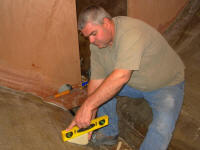
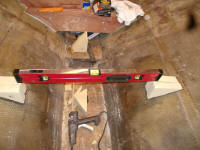

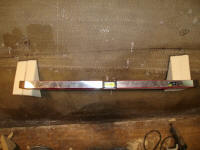
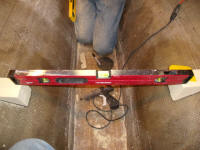
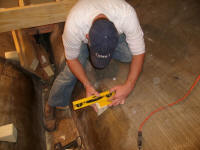
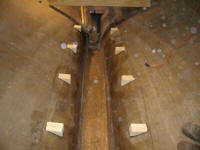
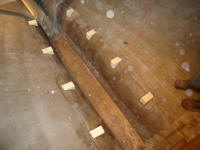


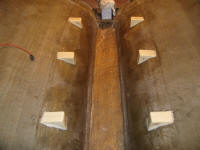
Finally, Brian patterned and cut out four layers of 18mm x 4" wide plywood for the aftermost beam, which would support the ends of the two sections of sole required to make up the total length of the sole. After epoxying and screwing the laminations together in the shop, we installed the beam permanently with thickened epoxy, holding it level and plumb. The stick seen on one side helped hold the beam from rocking while the epoxy cured.
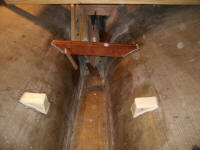

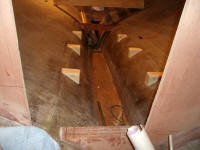
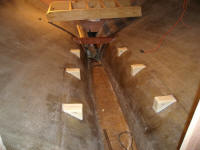
We filled the last vestiges of daylight (and beyond) with various miscellany, including permanently installing the starboard main bulkhead splice piece with screws and epoxy, and discussions related to the ongoing progress of the boat.

Total Time on This Job Today: 10 hours (times two)

